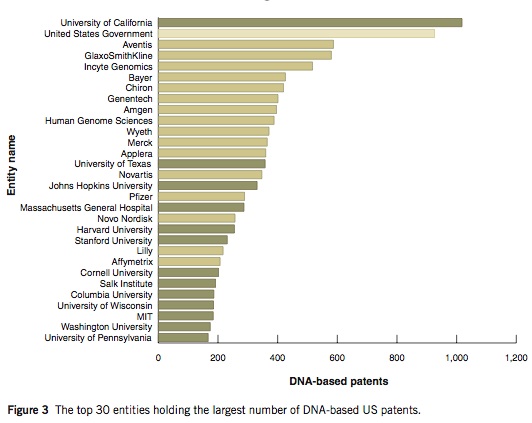Diagnostic Kits/IP Profile of Universities working in Kits
Answer the questions:
(ADDED TO PAPER)
- What are the 5 top Universities in this field?
- Correlate them with their main outputs (Data. Narratives. Tools)
- Understand and identify cases where these universities are “experimenting” or “adopting” commons based approach. Are they adopting OA policies, for instance? Are they adopting Social Responsible License approaches?
- Identify these cases and treat them as entities that will also be placed in our mapping device (the quadrants)
- Identify what universities are the “Microsofts” of the field and what companies are the “IBMs” of the field (Use the questionnaire to guide your research when appropriate - Carol will select specific relevant questions)
Top Universities (holders of the largest number of DNA-based US Patents (Pressman, L. et al., 2006)
- University of California
- University of Texas
- Johns Hopkins University
- Harvard University
- Standford University
- Cornell University
- Columbia University
- University of Wisconsin
- MIT
- Washington University
2005 Data from (Pressman, L. et al., 2006):
- Total DNA Patents (not just diagnostic kits) 38,282
- Total DNA Patents (not just diagnostic kits)owned by top 30 academic institutions 5,702
Add
Walsh, J. , Cho, C. & Cohen, W.M. Patents, Material Transfers and Access to Research Inputs in Biomedical Research (Final Report to the National Academy of Sciences' Committee [on] Intellectual Property Rights in Genomic and Protein-Related Research Inventions, 20 September 2005)....
Important Univ. Institution The [Center for Public Genomics is a Center of Excellence in Ethical, Legal, and Social Implications] (ELSI) Research co-funded by the Department of Energy and the National Human Genome Research Institute, part of the National Institutes of Health.
Genes are tools and outputs of research
- Research tools: "ideas, data, materials or methods used to conduct research." (Pressman, L. et al., 2006)
- "The gene patent subset of DNA patents has also been drawn into the research tools debate because genes are not only inputs to developing genetic tests and therapeutic proteins, and thus directly relevant to medically important products and services, but are also crucially important tools for ongoing research." (Pressman, L. et al., 2006)
Licensing
- The National Institutes of Health is a major source of resource biomedical funding.
- The funding power held by the National Institutes of Health has allowed it to create "guidelines for grantee institutions about how to license biomedical research resources arising from federally funded research." (Pressman, L. et al., 2006)
- Agreeing to comply with the licensing guidelines is a factor in receiving National Institutes of Health funding.
- These guidelines apply to all genomic inventions and are published under: Best practices for the licensing of genomic inventions. Federal Register 70, 18413-18415 (2005).
- The guidelines favor "broad and nonexclusive" licenses
DNA Patent Ownership Data
- "Roughly 78% of US DNA patents are owned by for-profit entities and 22% by nonprofits." (Pressman, L. et al., 2006)
Research-Use Rights Academic institutions involved in the research survey retained research-use rights for themselves (a shop right) and included a right to transfer these research-use rights to other nonprofit institutions in their license.
Academic Licensing Data Of the 19 responding tech transfer offices, "approximately 70% of the 2,607 managed patents have either been licensed in the past or are still under license." (Pressman, L. et al., 2006)
Exclusivity
- two types were considered by the study described in the Pressman article: (Pressman, L. et al., 2006)
- exclusive, all fields of use
- exclusive, by field of use
- Data on exclusivity is unclear because it often does not differentiate between these two types.
- Many times, company type, determines level of exclusivity
- "Startups have, in nearly all cases, exclusive licenses, although only about two-thirds have 'exclusive, all fields of use' licenses" (Pressman, L. et al., 2006)
- The larger the company, the less likely the license is to be exclusive
- Milestones (required showings of progress) are almost twice as likely in exclusive licenses as compared to non exclusive licenses. (Pressman, L. et al., 2006)
- A pilot survey on the licensing of DNA inventions focuses on the: ((Henry, M.R., et al., 2003))
- patenting and out-licensing strategies
- licensing negotiations: exclusivity, uses, and terms
- Protection of non-patented technologies: MTAs, NDAs
*"The high proportion of exclusive licenses by non-profits raises the implication that invention coming out of nonprofit institutions is more likely to be tied up with exclusive rights. However, our results, and those of Mowery et al.15 show that only 15 percent of university DNA sequence inventions are patented, suggesting that the bulk of such inventions will be made freely available upon scientific publication." ((Henry, M.R., et al., 2003))
- Institutions chosen for the study had patents of inventions using human DNA and both for profit and non-profits were sampled. The study found that for profit and non-profit entities approach patent and licenses differently:
- Patenting Behavior ((Henry, M.R., et al., 2003))
- For profits more often fill patent applications for all new technologies and then deciding what to pursue based on commercial interest.
- Non-profits were more selective about when to apply for a patent.
- Licensing Behavior ((Henry, M.R., et al., 2003))
- For both entities, licensing was most often used as a method of commercialization. Licensing for research was very infrequent.
- One important difference found was that nonprofits were more than twice as likely to license exclusively as compared to for-profit companies.
- Patenting Behavior ((Henry, M.R., et al., 2003))
